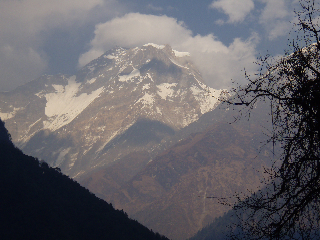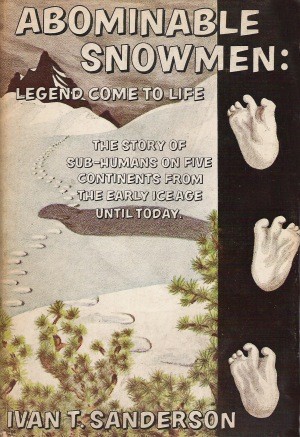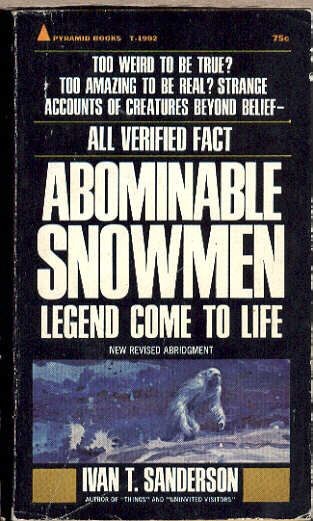October 26, 2009
Origins of “Abominable Snowman”

Setting the record straight…
On MonsterQuest on October 25, 2009, during their generally well-done “Abominable Snowman” program, one individual who has been on Yeti expeditions was interviewed about the origins of the term “Abominable Snowman” of the Himalaya. This person has either forgetfully or confusingly misstated the facts behind this incident before, on other television documentaries, and he regaled the interviewer with pieces of misinformation that must be corrected.
The Irish explorer was quoted as saying that a 1921 mistranslation was related to a word that meant “abominable or foul-smelling” man or snowman. This business about the odor of the Yeti or humans smelling the Yeti has nothing to do with the terminology of the “Abominable Snowman.” Yet this false origin keeps creeping in during this one person’s interviews (e.g. in a 1992 Unsolved Mysteries interview).
To place on the record, once again, the history behind the phrase “Abominable Snowman,” here is what is generally known. (The following quotations are in bold to retain the italics in the book titles and the non-English words of note.)
Even a cursory examination of the passage about Lt. Colonel C. K. Howard-Bury at Wikipedia gives a closer-to-reality retelling of the origins of the term “Abominable Snowman”:
During the 1921 expedition Charles Howard-Bury found many footprints at high altitude, he later pronounced that the tracks “were probably caused by a large ‘loping’ grey wolf,” however his Sherpas were quick to offer that they were the tracks of a metch kangmi (meaning “filthy snowman”). (Mount Everest The Reconnaissance, 1921).
It was at this time that Henry Newman of The Statesmanin Calcutta (now Kolkata) obtained descriptions from the expedition’s porters on their return to Darjeeling.
Bill Tilman writes in his book (Mount Everest 1938) that Newman mistranslated metch kangmi as “abominable snowman”; hence the phrase “Abominable Snowman” came into existence in 1921.
Later Newman wrote in a letter to The Times: “The whole story seemed such a joyous creation I sent it to one or two newspapers.”
[Ralph] Izzard adds “whatever effect Mr. Newman intended, from 1921 onwards the Yeti – or whatever various native populations choose to call it – became saddled with the description “Abominable Snowman”, an appellation which can only appeal more to the music-hall mind than to mammologists, a fact which has seriously handicapped earnest seekers of the truth.” (The Abominable Snowman Adventure, 1955.)

In Ivan T. Sanderson’s 1961 book, Abominable Snowmen: Legend Come To Life, he details in some depth this episode:
In that year an incident occurred that was impressive enough but which might have been either wholly or temporarily buried had it not been for a concatenation of almost piffling mistakes. In fact, without these mistakes it is almost certain that the whole matter would have remained in obscurity and might even now be considered in an entirely different light or in the status of such other mysteries as that of “sea-monsters.” This was a telegram sent by Lt. Col. (now Sir) C. K. Howard-Bury, who was on a reconnaissance expedition to the Mt. Everest region.
The expedition was approaching the northern face of Everest, that is to say from the Tibetan side, and when at about 17,000 feet up on the Lhapka-La pass saw, and watched through binoculars, a number of dark forms moving about on a snowfield far above. It took them some time and considerable effort to reach the snowfield where these creatures had been but when they did so they found large numbers of huge footprints which Colonel Howard-Bury later stated were about “three times those of normal humans” but which he nonetheless also said he thought had been made by “a very large, stray, grey wolf.” (The extraordinarily illogical phrasing of this statement will be discussed later on, but it should be noted here that a large party of people had seen several creatures moving about, not just “a wolf,” and that it is hard to see how the Colonel could determine its color from its tracks.) However, despite these expressions, the Sherpa porters with the expedition disagreed with them most firmly and stated that the tracks were made by a creature of human form to which they gave the name Metoh-Kangmi.
Colonel Howard-Bury appears to have been intrigued by this scrap of what he seems to have regarded as local folklore, but, like all who have had contact with them, he had such respect for the Sherpas, that he included the incident in a report that he sent to Katmandu, capital of Nepal, to be telegraphed on to his representatives in India. And this is where the strange mistakes began. It appears that Colonel Howard-Bury in noting the name given by the Sherpas either mistransliterated it or miswrote it: he also failed to realize that he was dealing with one of several kinds of creatures known to the Sherpas and that they, on this occasion, apparently both in an endeavor to emphasize this and for the sake of clarity used as a generic term for all of them, the name kang-mi, which was a word foreign to their language. This is a Tibetan colloquialism in some areas, and is itself partly of foreign origin even there, in that kang, is apparently of Chinese origin while miis a form of Nepalese meh. The combination thus meant “snow creature.” His metoh would better have been written meh-teh, a name of which we shall hear much, and which turns out to mean the meh or man-sized tehor wild creature. However, the Indian telegraphist then got in the act and either he dispatched this word as, or it was transcribed in India, as metch.
The recipients in India were unfamiliar with any of the languages or dialects of the area but they were impressed by the fact that Howard-Bury had thought whatever it might be, important enough to cable a report, so they appealed to a sort of fount of universal wisdom for help. This was a remarkable gentleman named Mr. Henry Newman who has for years written a most fascinating column in the Calcutta Statesman on almost every conceivable subject and who has the most incredible fund of information at his finger tips. This gentleman, however, did not really know the local languages or dialects of eastern Tibet and Nepal either, but this did not deter him from giving an immediate translation of this metch kangmiwhich, he stated categorically, was Tibetanfor an “abominable snowman.” The result was like the explosion of an atom bomb.
Nobody, and notably the press, could possibly pass up any such delicious term. They seized upon it with the utmost avidity, and bestowed upon it enormous mileage but almost without anything concrete to report. The British press gulped this up and the public was delighted. Then there came a lull in the storm. During this time, it now transpires, a number of eager persons started a fairly systematic search for previous reports on these abominable creatures, and they came up with sufficient to convince their editors that the story was not just a flash in a pan, but a full-fledged mystery that had actually been going on for years.

BTW, this member of the Slick-Johnson Snowman expeditions, during his MonsterQuest interview, also misstated the educational background of Tom Slick. This person said that Slick was a graduate of Harvard, probably in “physics.” Actually, from primary research I conducted on his educational records and family history, the public record clearly demonstrates that Tom Slick graduated from Yale with a degree in premedicine biology, as referenced in Tom Slick: True Life Encounters in Cryptozoology (Fresno, CA: Craven Street-Linden Press, 2002).
While the story-telling of the MonsterQuest episode was excellent, with Adam Davies-led trek into the region of Nepal being intriguing, Ian Redmond’s ecological statements truly educational, and Dr. Jeff Meldrum’s footprint conclusions, of course, spot-on, I found it important to add a bit of a postscript so this continued uncomfortable business about “foul-smelling” being associated with the term “Abominable Snowman” gets explained with a look at the record (again) as quickly as possible.
++++++
Thank you.
 About Loren Coleman
About Loren Coleman
Loren Coleman is one of the world’s leading cryptozoologists, some say “the” leading living cryptozoologist. Certainly, he is acknowledged as the current living American researcher and writer who has most popularized cryptozoology in the late 20th and early 21st centuries.
Starting his fieldwork and investigations in 1960, after traveling and trekking extensively in pursuit of cryptozoological mysteries, Coleman began writing to share his experiences in 1969. An honorary member of Ivan T. Sanderson’s Society for the Investigation of the Unexplained in the 1970s, Coleman has been bestowed with similar honorary memberships of the North Idaho College Cryptozoology Club in 1983, and in subsequent years, that of the British Columbia Scientific Cryptozoology Club, CryptoSafari International, and other international organizations. He was also a Life Member and Benefactor of the International Society of Cryptozoology (now-defunct).
Loren Coleman’s daily blog, as a member of the Cryptomundo Team, served as an ongoing avenue of communication for the ever-growing body of cryptozoo news from 2005 through 2013. He returned as an infrequent contributor beginning Halloween week of 2015.
Coleman is the founder in 2003, and current director of the International Cryptozoology Museum in Portland, Maine.
Email • Facebook • Twitter •
Filed under Abominable Snowman, Cryptomundo Exclusive, Cryptotourism, CryptoZoo News, Expedition Reports, Media Appearances, Men in Cryptozoology, Television



